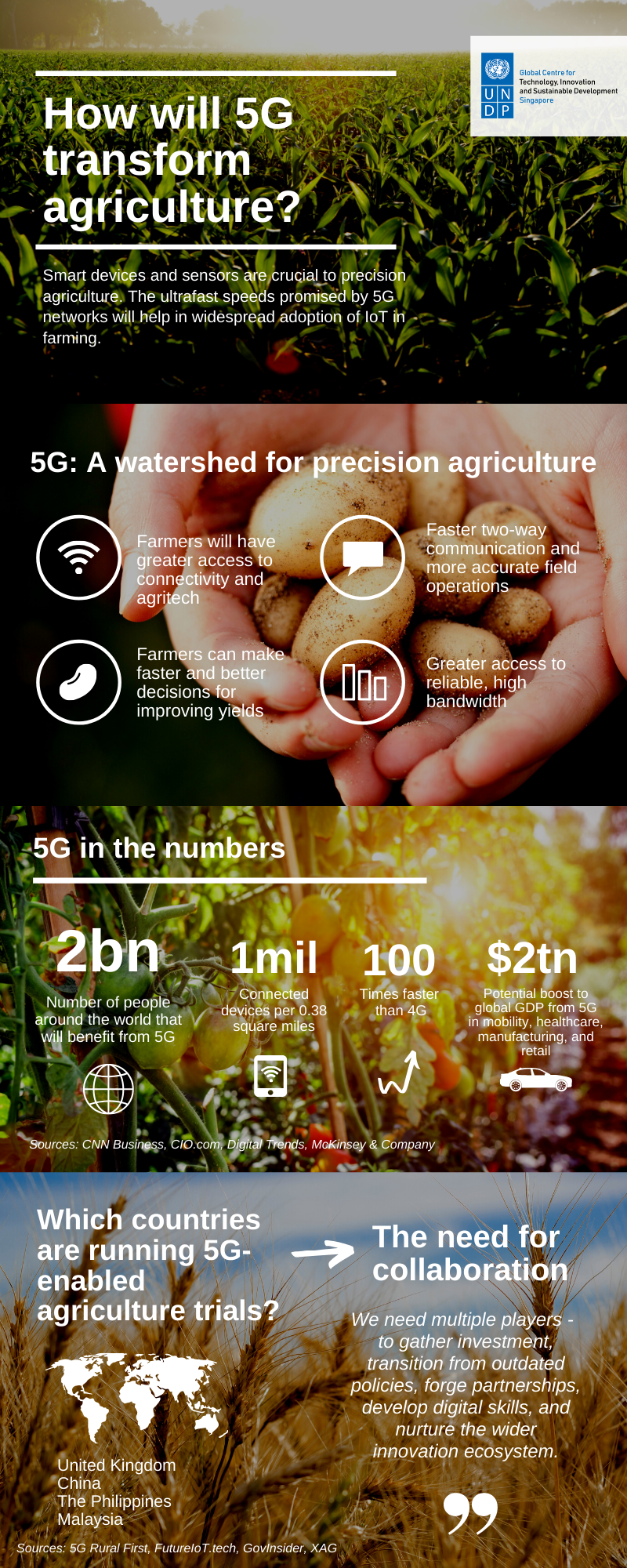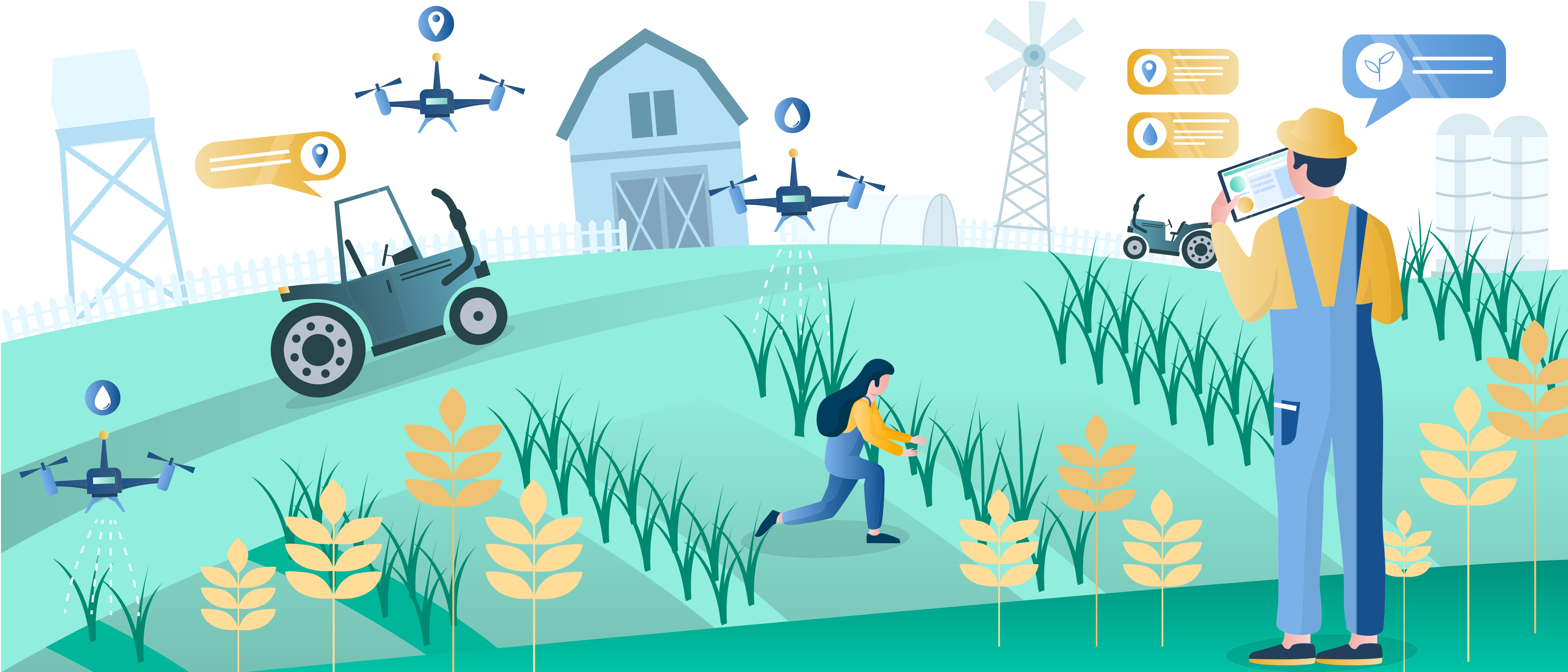5G, the next generation of connectivity, promises ultrafast speeds and near-real time response. The initial installations of 5G will cover a quarter of the world’s population by 2030, McKinsey predicts. This could potentially transform the sectors of mobility, healthcare and manufacturing, just to name a few.
The wider implementation of 5G could also present interesting opportunities for the developing world. What does it mean for development? Will its benefits outweigh the costs and challenges that these countries may face?
One bright spot is in agriculture. IoT devices and sensors used on farms and crop fields could get a real boost from the near real-time speeds that 5G networks offer – but obstacles remain.
But these benefits come at a price — high infrastructure costs. Deploying 5G could cost double for operators as they would need to upgrade existing 4G networks. McKinsey estimates that this could cost up to $900 billion in order to meet the predicted coverage by 2030.
For developing countries, the challenges are even greater. For most, 3G or 4G infrastructure is often absent or lacking. There is a lack of financial incentive for mobile network operators to build the needed infrastructure, given its high costs in rural areas. These can be as much as triple the cost of urban deployments — and with significantly lower revenue opportunities.
Setting aside infrastructure costs, they also have to contend with policy issues, including spectrum challenges and barriers to infrastructure investment, among others. It may be long before developing countries can deploy 5G, but it is crucial to highlight the importance of its networks that can help them leap forward in many sectors.
Smart devices and sensors can help farmers increase yields and increase efficiency, but require immense resources and data speeds. With more devices and data, it will be challenging even for some 4G networks to cope. 5G can overcome this, providing real-time, high-speed communications among these sensors and devices. This could be a watershed for precision agriculture; here is how:

A quick look at the impacts and opportunities for 5G for agriculture. Credits: Nurfilzah Rohaidi
The benefits of 5G-enabled smart farming will also have broader positive effects that will be transferred to the global food system. The collective ability of farmers to produce more food more efficiently may be how the world feeds the global population, which will hit nine billion by 2030 according to projections by the United Nations. In fact, some argue that 5G is necessary to meet future farming demands in more developed countries.
This may well be the missing piece of the puzzle for the agritech ecosystem to really take flight across both the developed and developing world.
5G-enabled precision farming will considerably assist farmers in tackling challenges brought on by climate change. It can help farmers better manage pests and diseases. Existing technologies enable farmers to collect data from IoT-enabled remote sensors on climatic conditions and crop health. These tools also use artificial intelligence or machine learning algorithms to predict crop susceptibility to disease, and inform farmers of where exactly pests and diseases are affecting crops.
These technologies can also provide actionable insights to tackle these diseases and enable the automation and precision of pesticide use. 5G can make this quicker, more efficient and more accurate.

A smart farm will be digitally connected and managed at every aspect; 5G will make smart farms even more possible, with greater capabilities. © Siberian Art / Adobe Stock
The wider implementation of 5G could also present interesting opportunities for the developing world. What does it mean for development? Will its benefits outweigh the costs and challenges that these countries may face?
One bright spot is in agriculture. IoT devices and sensors used on farms and crop fields could get a real boost from the near real-time speeds that 5G networks offer – but obstacles remain.
Challenges and opportunities
About two billion people worldwide are predicted to benefit from the advantages of 5G, according to the McKinsey report. 5G networks enable significantly faster data speeds, wider mobility support, and higher connection density, for instance.But these benefits come at a price — high infrastructure costs. Deploying 5G could cost double for operators as they would need to upgrade existing 4G networks. McKinsey estimates that this could cost up to $900 billion in order to meet the predicted coverage by 2030.
For developing countries, the challenges are even greater. For most, 3G or 4G infrastructure is often absent or lacking. There is a lack of financial incentive for mobile network operators to build the needed infrastructure, given its high costs in rural areas. These can be as much as triple the cost of urban deployments — and with significantly lower revenue opportunities.
Setting aside infrastructure costs, they also have to contend with policy issues, including spectrum challenges and barriers to infrastructure investment, among others. It may be long before developing countries can deploy 5G, but it is crucial to highlight the importance of its networks that can help them leap forward in many sectors.
The next frontier of smart farming
5G will greatly aid how farmers digitally transform ways of working. Smart farming and precision agriculture are highly dependent on IoT devices to support communication between data from the field and smart devices used for farm management.Smart devices and sensors can help farmers increase yields and increase efficiency, but require immense resources and data speeds. With more devices and data, it will be challenging even for some 4G networks to cope. 5G can overcome this, providing real-time, high-speed communications among these sensors and devices. This could be a watershed for precision agriculture; here is how:
- Access to greater connectivity and more possibilities — farmers can implement a broad suite of technologies that are able to work in tandem, such as mobile apps, automated equipment, drones, sensors and data transmission. The case of the city of Cauayan in the Philippines is a great example of how an agricultural town can become a smart city through leveraging 5G technology. The city government has partnered with the largest telco in the Philippines to pioneer the use of a 5G network in the country. The government will also train and develop farmers’ skills and knowledge through the Digital Farmers Programme, so they are better equipped to use these technologies.
- Faster two-way communication and more accurate field operations by sharing data more quickly and efficiently. An initiative based in the UK has demonstrated this. 5G Rural First launched the smartphone app Me+Moo in March last year, which allows farmers to track cows that are fitted with IoT collars and leg sensors, and receive updates on their health and behaviour. This data provides farmers with important information to relay to veterinarians or nutritionists, and keeps them well-informed of potential health problems on the farm.
- Ability to make faster and better decisions while improving machine performance for greater productivity, efficiency, and yields. In China, the leading telecom supplier Huawei Technologies announced a partnership with XAG, a manufacturer of agricultural drones, to implement a smart agriculture project to trial the use of 5G, artificial intelligence and cloud computing in agriculture. This has been targeted to optimise the performance and efficiency of smart agricultural devices, through the ability of 5G technology to seamlessly transmit and process data as well as improve the control accuracy of drones and robots. Elsewhere in the region, Malaysia is also looking into using 5G to enable better precision farming.

A quick look at the impacts and opportunities for 5G for agriculture. Credits: Nurfilzah Rohaidi
The benefits of 5G-enabled smart farming will also have broader positive effects that will be transferred to the global food system. The collective ability of farmers to produce more food more efficiently may be how the world feeds the global population, which will hit nine billion by 2030 according to projections by the United Nations. In fact, some argue that 5G is necessary to meet future farming demands in more developed countries.
This may well be the missing piece of the puzzle for the agritech ecosystem to really take flight across both the developed and developing world.
The fight against climate change
The effects of climate change on global agriculture are sobering. A report by the National Academy of Sciences estimates that each degree Celsius increase in global mean temperature could reduce global yields of soybeans by 3%, wheat by 6%, and corn by 7%. One reason is the effects of climate change on animal pests and diseases, as these changes can make them expand into new regions, creating invasive species that can be detrimental to crops.5G-enabled precision farming will considerably assist farmers in tackling challenges brought on by climate change. It can help farmers better manage pests and diseases. Existing technologies enable farmers to collect data from IoT-enabled remote sensors on climatic conditions and crop health. These tools also use artificial intelligence or machine learning algorithms to predict crop susceptibility to disease, and inform farmers of where exactly pests and diseases are affecting crops.
These technologies can also provide actionable insights to tackle these diseases and enable the automation and precision of pesticide use. 5G can make this quicker, more efficient and more accurate.

A smart farm will be digitally connected and managed at every aspect; 5G will make smart farms even more possible, with greater capabilities. © Siberian Art / Adobe Stock





